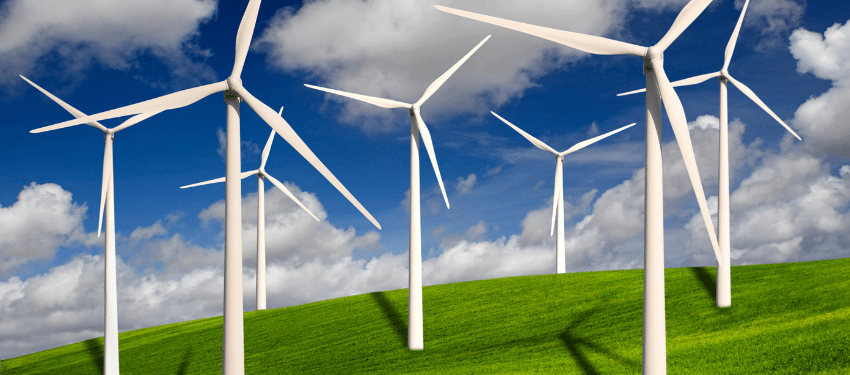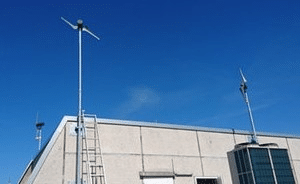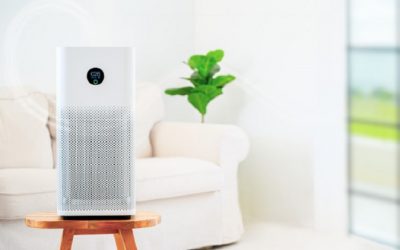Small Wind Turbine for Home

India’s renewable energy sector has witnessed tremendous growth, and among the various sources, wind energy emerges as a highly effective solution to address concerns related to depleting fossil fuels, coal imports, greenhouse gas emissions, and environmental pollution. When choosing a turbine, it is essential to consider several factors to ensure it aligns with your requirements. These factors include the appropriate size, suitability for the available wind resource, reliability, warranty, availability of spare parts, and the proximity of operation and maintenance providers. By carefully considering these aspects, you can select a turbine that best suits your needs.
A wind turbine is a device that converts kinetic energy of wind into electrical energy. They’re much more compact though — small enough to install either on your roof or in your garden – and some have curved blades, not unlike a whisk. Small wind turbines still function like their bigger counterparts — you’ll get clean electricity generated entirely by the power of wind. As a renewable and non-polluting source, wind energy offers a sustainable and affordable alternative, reducing the dependence on traditional fuel sources and transportation. By harnessing wind power, India can significantly contribute to the generation of green and clean electricity.
Types of Small Wind Turbines for Home
There are two main types of home wind turbines
- Horizontal axis turbines
- Vertical axis turbines
These turbines can either be placed on a rooftop or as a standalone tower. When choosing a standalone tower, the placement and build are important.
Roof-mounted wind turbines

Roof-mounted wind turbines are installed on top of your roof. It’s typically cheaper to install a roof-mounted turbine than a standalone one, although their size means they are less powerful. You can normally generate around 1–2 kilowatts (kW) of electricity.
Standalone wind turbines

Standalone wind turbines are more powerful than roof-mounted turbines, because they’re bigger and can take better advantage of the wind. It still depends where you place them though — a standing turbine flanked by trees or taller buildings isn’t going to be optimal. They work most efficiently in open spaces, which means standalone wind turbines are best suited for rural properties with a lot of land. That makes them less ideal for urban environments. Standalone wind turbines typically generate between 3–15 kW per day, and some of the largest models can generate more than 25 kW.
Top Wind Turbine Manufacturers in India
- Siemens
- Suzlon
- Winds of the World (India)
- Regen Powertech private limited
- Inox Wind limited
- Orient Green Power Limited
- Indowind Energy Limited
- RRB Energy Limited (India)
- Vestas India – International Players
- Enercon India Pvt limited – International Players
- Gamesa wind turbines private limited – International Players
- GE Wind Energy Limited – International Players
How long does it take to install?
Installing a roof-mounted turbine can be done in few hours by a professional. Standalone wind turbines can take longer. It’s always best to get a trusted professional to install your wind turbine, especially with standalone systems.
How Do Wind Turbines Work?
Wind turbines use wind to make electricity. Wind turns the propeller-like blades of a turbine around a rotor. The turbines are connected to shafts. When the turbines turn, the shaft turns. The shaft then turns a generator. The turning of the generator creates a flow of electrons, which creates electricity that an external battery bank stores. .
You must place wind turbines in an area that receives a minimum amount of wind according to the supplier. For an average home wind turbine, that’s usually a wind speed of 5.5 mph or more. Without this minimum amount of wind, the blades just won’t spin, and no electricity will be produced. However, the rated energy output of a turbine can’t be achieved unless the turbine has access to its rated wind speed, which is the average amount of wind needed to get the generator producing at max capacity. For example, a 500W turbine rated for 27 mph wind speeds will only generate around 100W of power when the wind is 10-12 mph.
Advantages of Wind Power
- Wind is a form of clean and renewable energy
- Installation time is less
- Fuel cost is zero
- Operation & Maintenance cost is very low
- There is no adverse effect on the environment. The whole system is pollution free and environment friendly
- Wind turbines save space
- Wind power generation promotes domestic economic growth
Challenges of Wind Power
- Wind power must compete with other low-cost energy sources
- Turbines produce noise and alter visual aesthetics
- Wind turbines can be dangerous to some wildlife(birds)
- Wind power is limited by location
Which is better: 3 blade or 5 blade wind turbine?
Compared to the traditional three blade wind turbine, a five-blade turbine can increase annual performance. The speed of the blades of a five-blade turbine is 60% of the three-blade wind turbine. Five-blade wind turbines reduce the chance of high-speed malfunction.
Capacity
Small wind turbines used in residential applications generally range in size from 400 watts to 20 kilowatts, depending on the amount of electricity you want to generate. A 1.5-kilowatt wind turbine will meet the needs of a home requiring 300 kilowatt-hours per month in a location with a 6.26 meters-per-second annual average wind speed.
Grid-Connected Small Wind Electric Systems
Small wind energy systems can be connected to the electricity distribution system. These are called grid-connected systems. A grid-connected wind turbine can reduce your consumption of utility-supplied electricity for lighting, appliances, electric heating and cooling, and vehicle charging. If the turbine cannot deliver the amount of energy you need, the utility makes up the difference. When the wind system produces more electricity than your household requires, the excess is credited and used to offset future use of utility-supplied power.
Wind Power in Isolated Grid Systems
Wind power can be used in isolated off-grid systems, or microgrid systems, not connected to an electric distribution grid. In these applications, small wind electric systems can be used in combination with other components — including a small solar electric system — to create hybrid power systems. Hybrid power systems can provide reliable off-grid power for homes, farms, or even entire communities that are far from the nearest utility lines.
Wind Resource Considerations — You can have varied wind resources within the same property. In addition to measuring or finding out about the annual wind speeds, you need to know about the prevailing directions of the wind at your site. In addition to geological formations, you need to consider existing obstacles, such as trees, houses, and sheds. You also need to plan for future obstructions, such as new buildings or trees that have not reached their full height. Your turbine needs to be sited upwind of any buildings and trees.
System Considerations — It is encouraged that you only consider small wind turbines that have been tested and certified to national performance and safety standards. You will need to take the length of the wire run between the turbine and the load (house, batteries, water pumps, etc.) into consideration. Using larger wire will also increase your installation cost. Your wire run losses are greater when you have direct current (DC) instead of alternating current (AC). If you have a long wire run, it is advisable to invert DC to AC.
Is wind or solar better?
Wind is a more efficient power source than solar. Compared to solar panels, wind turbines release less CO2 to the atmosphere, consume less energy, and produce more energy overall.
Can you put a wind turbine on your roof?
Wind turbines achieve optimal performance in open areas where there are no barriers or obstructions that disrupt wind patterns. Consequently, turbines installed in urban areas are generally less efficient. To maximize energy production, it is crucial to have a consistent wind flow in terms of both speed and direction.
Installing a rooftop small wind turbine makes sense if you can get the equipment high enough and out of the way of obstacles. Of course, living in a windy area also helps. Otherwise, the installation and maintenance costs might outweigh the savings due to a lack of sustained winds. Several field trials have found that building-mounted turbines perform poorly, producing only a small fraction of the energy they would produce if properly sited. Standalone wind turbines are more powerful than roof-mounted turbines.
How much does a small wind turbine cost in India?
The pricing for small wind turbines typically begins at Rs 70,000 per kW. These costs vary based on factors such as the materials used, the technology employed, the location, and whether the turbine is grid-connected.
What is the minimum wind turbine size?
Turbine blades for small wind turbines are typically 1.5 to 3.5 metres (4 ft 11 in – 11 ft 6 in) in diameter and produce 0.5-10 kW at their optimal wind speed.
What is the Service Life of the Wind Turbine?
Wind turbines are designed for a service life of 20-25 years. During this period, it is possible to replace the blades of the main mechanisms. In any case, this issue should be specified when ordering a wind turbine.
What to Look for when Buying a Wind Turbine?
The turbine you decide to purchase must fit your needs for size, wind resource, availability, reliability, warranty, spare parts availability, and proximity of operation and maintenance teams.
Are Wind Turbines Noisy?
Modern wind turbines generate minimal noise. While the turbine blades may produce a whooshing sound when encountering air turbulence, this noise is typically overshadowed by the natural background noise of the blowing wind.
Small wind turbine for home with specifications and prices. Survey was conducted in May 2023.
|
S.No. |
Brand |
Capacity in watt |
Specifications |
Price, Rs. |
|
1 |
Layfuz
|
1200
|
Colour: White |
35000 |
|
2 |
Zhangxi |
1200 |
Voltage: 12 Volts Special Feature: Portable Colour: White Total Power Outlets:1 Frequency: 50 Hz Aluminium alloy body and nylon fibre bs, with high temperature spray casting, ultraviolet-proof, acid rain proof, durable to use, can stand bad weather conditions and fit for outdoor use. |
50350 |
|
3 |
Layfoxz |
1200 |
Aluminium Alloy Shell Nylon Fibre B B: 5 B s Shape: Lantern Rated Voltage: 12V Maximum Start-up Wind Speed: 2m/s Rated Wind Speed: 12m/s Working Temperature: -40℃~80℃ Item Size: 60 * 90cm / 23.6 * 35.4in (H * Dia.) Package Size: 61 * 44 * 30cm |
48359 |
|
4 |
Layfoxz |
1200 |
Colour: White Material: Aluminium Alloy Shell Nylon Fibre B B : S-Type, 5 B s Rated Voltage: 12V Maximum Power: 1200W (Under ideal environment which includes wind speed, temperature, surrounding building and more) Start-up Wind Speed: 2m/s Rated Wind Speed: 12m/s Working Temperature: -40℃~80℃ Item Size: 66 * 120cm / 26.0 * 47.2in |
34919 |
|
5 |
Zhangxi |
1200 |
Colour: White Wattage: 1200 Watts Voltage:12 Volts Special Feature: Portable Frequency: 50 Hz Aluminium alloy body and nylon fibre b s, with high temperature spray casting, ultraviolet-proof |
50939 |
|
6 |
AIXING |
1200 |
Lantern Wind Turbine Generator Voltage:12 Volts Special Feature: Portable Total Power Outlets:1 Frequency: 50 Hz Aluminium alloy body and nylon fibre bs, with high temperature spray casting, ultraviolet-proof, acid rain proof, |
60804 |
|
7 |
AIXING |
1200 |
Wattage:1200 Watts Special Feature: Portable Total Power Outlets: 1 Frequency: 50 Hz
|
43564 |
|
8 |
Socialme |
400 |
Model: NE-400R |
45599 |
|
9 |
Layfuz
|
400 |
Colour: White |
34064 |
Source: amazon.in
Note: for latest prices check at amazon.in or get quotation from https://www.indiamart.com.We will be publishing updated report on this product in next year.
Reference: https://www.energy.gov
Related
Home Air Purifier – Important Terms to know
Air Purifiers are the need of the hour. It can refresh stale air and can reduce the chances of health issues caused by air pollution, which can...

